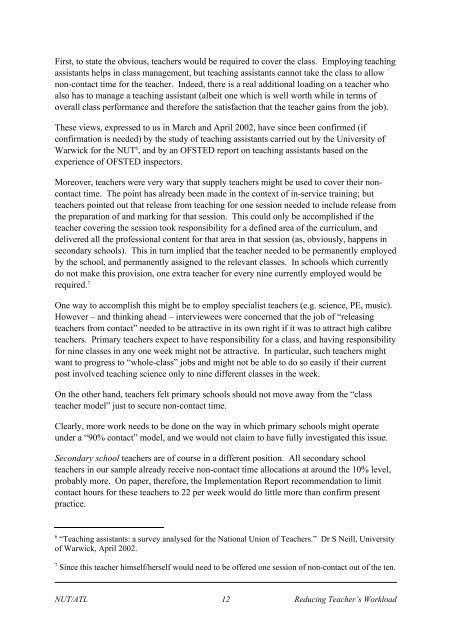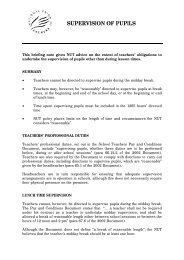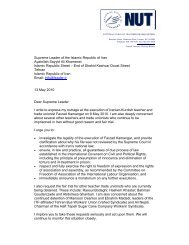Reducing Teachers' Workload â A Way Forward - National Union of ...
Reducing Teachers' Workload â A Way Forward - National Union of ...
Reducing Teachers' Workload â A Way Forward - National Union of ...
Create successful ePaper yourself
Turn your PDF publications into a flip-book with our unique Google optimized e-Paper software.
First, to state the obvious, teachers would be required to cover the class. Employing teaching<br />
assistants helps in class management, but teaching assistants cannot take the class to allow<br />
non-contact time for the teacher. Indeed, there is a real additional loading on a teacher who<br />
also has to manage a teaching assistant (albeit one which is well worth while in terms <strong>of</strong><br />
overall class performance and therefore the satisfaction that the teacher gains from the job).<br />
These views, expressed to us in March and April 2002, have since been confirmed (if<br />
confirmation is needed) by the study <strong>of</strong> teaching assistants carried out by the University <strong>of</strong><br />
Warwick for the NUT 6 , and by an OFSTED report on teaching assistants based on the<br />
experience <strong>of</strong> OFSTED inspectors.<br />
Moreover, teachers were very wary that supply teachers might be used to cover their noncontact<br />
time. The point has already been made in the context <strong>of</strong> in-service training; but<br />
teachers pointed out that release from teaching for one session needed to include release from<br />
the preparation <strong>of</strong> and marking for that session. This could only be accomplished if the<br />
teacher covering the session took responsibility for a defined area <strong>of</strong> the curriculum, and<br />
delivered all the pr<strong>of</strong>essional content for that area in that session (as, obviously, happens in<br />
secondary schools). This in turn implied that the teacher needed to be permanently employed<br />
by the school, and permanently assigned to the relevant classes. In schools which currently<br />
do not make this provision, one extra teacher for every nine currently employed would be<br />
required. 7<br />
One way to accomplish this might be to employ specialist teachers (e.g. science, PE, music).<br />
However – and thinking ahead – interviewees were concerned that the job <strong>of</strong> “releasing<br />
teachers from contact” needed to be attractive in its own right if it was to attract high calibre<br />
teachers. Primary teachers expect to have responsibility for a class, and having responsibility<br />
for nine classes in any one week might not be attractive. In particular, such teachers might<br />
want to progress to “whole-class” jobs and might not be able to do so easily if their current<br />
post involved teaching science only to nine different classes in the week.<br />
On the other hand, teachers felt primary schools should not move away from the “class<br />
teacher model” just to secure non-contact time.<br />
Clearly, more work needs to be done on the way in which primary schools might operate<br />
under a “90% contact” model, and we would not claim to have fully investigated this issue.<br />
Secondary school teachers are <strong>of</strong> course in a different position. All secondary school<br />
teachers in our sample already receive non-contact time allocations at around the 10% level,<br />
probably more. On paper, therefore, the Implementation Report recommendation to limit<br />
contact hours for these teachers to 22 per week would do little more than confirm present<br />
practice.<br />
6 “Teaching assistants: a survey analysed for the <strong>National</strong> <strong>Union</strong> <strong>of</strong> Teachers.” Dr S Neill, University<br />
<strong>of</strong> Warwick, April 2002.<br />
7 Since this teacher himself/herself would need to be <strong>of</strong>fered one session <strong>of</strong> non-contact out <strong>of</strong> the ten.<br />
NUT/ATL 12 <strong>Reducing</strong> Teacher’s <strong>Workload</strong>
















